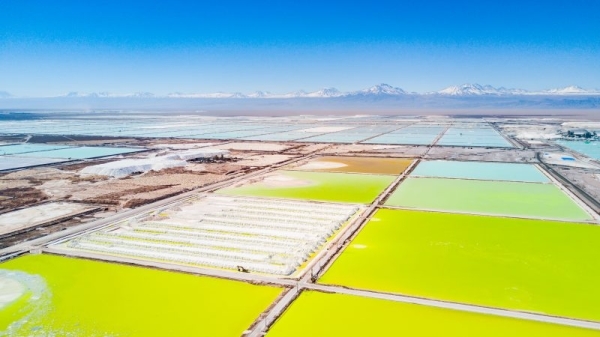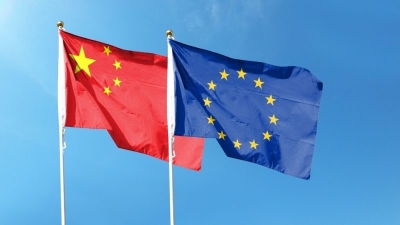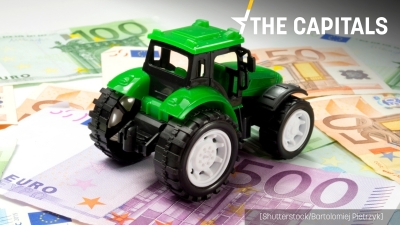Facing water stress: Chile’s lithium industry under scrutiny in Atacama Desert

Lithium extraction in Chile’s Atacama Desert exacerbates water stress in an already dry region but debate rages about the industry’s true impact as the government starts reviewing the exploitation of the desert’s resources.
In Chile, water management has been at the centre of an ongoing battle between mining companies, the government, environmental activists, and some communities living near the Atacama salt flats.
The region is one of the world’s driest, where rainfall rarely exceeds two millimetres a year. Water stress and droughts are, therefore, part of the ecosystem for local communities, who must now live alongside the growing lithium extraction industry.
Lithium is a key component in the manufacturing of batteries for electric cars and was recently added to the EU’s list of critical raw materials considered essential for the manufacturing of electric car batteries, mobile phones, and laptop computers.
Chile’s salt flats account for the world’s largest exploitable reserves. But views differ on how they should be used.
Christian Espindola, a farmer who lives near the flats, said he was worried about the future of his land. Interviewed as part of a 2021 investigation by media outlet Reporterre, he called for “the mines to go away”.
Juana Ansa Conzalez, a local resident, said lithium mining should not be expanded further. “Lithium mining is just a temporary window, while agriculture is a long-term process,” she told EURACTIV in February.
Water stress
As the lithium sector develops, more farmers are putting the industry’s sustainability pledges under scrutiny.
According to data from Chile’s largest lithium producer, SQM, manufacturing one tonne of lithium carbonate – a precursor to compounds used in lithium-ion batteries – requires about 600,000 litres of water.
The freshwater used for Chile’s lithium production comes from two sources – the desert subsoil and the brine pumped from underneath the Salar Grande in the Atacama Desert, which is stored in surface ponds for evaporation in order to extract the lithium.
In an endemically water-stressed region like the Atacama Salar, each water extraction risks disrupting the hydrological cycle, a process not yet fully understood.

Reserva Nacional Los Flamencos, Salar de Atacama, Chili, 1 March 2023.
What’s the true impact?
But is the disruption that important?
No, according to a study by the University of Massachusetts Amherst and the University of Alaska Anchorage, published in July 2022 and funded by German carmaker BMW and chemicals giant BASF.
According to the study, lithium extraction would indeed account for less than 10% of the region’s freshwater use and would not be connected to changes in surface water characteristics and water storage.
In total, the mining industry accounts for only 4% of Chile’s industrial water consumption –far behind the 73% used in agriculture and livestock, says the International Council on Mining and Metals (ICMM).
But the US researchers argue that the partial knowledge of the region’s hydrological cycles calls for caution. In their view, Chilean authorities must review the limits on water pumping they allow, saying the current thresholds are based on outdated hydrological and climatic data.
Currently, Chilean authorities allow the lithium industry to use a flow rate of up to 240 litres per second, SQM says.
And so far, the industry is keeping safely within those limits, according to a study by the Argonne National Laboratory at the University of Chicago, published in November 2021 and funded by SQM.
According to that study, the production of lithium carbonate from brine consumes 15.5 to 32.8 cubic metres of water per tonne produced, over its entire life cycle.
Meanwhile, only 2.95 to 7.30 m3/tonne of lithium are used for operations in the salar, SQM points out, saying these numbers take into account the consumption of freshwater pumped from the desert subsoil to compensate for the evaporation of water contained in the brine.
In short, water consumption from lithium mining in the Atacama Desert is well below the limits imposed by the Chilean government, the study shows.
The Chilean industry also fares much better than Australia’s, the world’s largest lithium producer. Over the entire life cycle, lithium production in Australia is 2 to 5 times more water-intensive than in Chile, according to the study.

Lithium brine extraction pool of Sociedad química y minera de chile (SQM), Salar de Atacama, Chili, 1 March 2023.
Improvements in sight?
Yet, the industry itself admits that the situation could improve and has set itself higher water efficiency targets for the coming years.
By 2028, SQM plans to reduce its brine extraction by 50%, according to the company’s 2021 sustainability report. Reconciling sustainability and growth involves “major technological challenges” and “significant risks”, the company says.
At the same time, Chile’s lithium extraction activity is only going to grow, in particular, to match increasing demand from the US and Europe for electric car batteries.
For now, care is recommended as knowledge about the region’s hydrological capacities and the climate – as well as the number of studies – remains limited.
NGOs like the Natural Resources Defense Council (NRDC), denounce the fact that lithium companies minimise the use of water needed to extract lithium from brine.
A study published in 2020 by the University of Antofagasta in Chile, raises concerns about the amount and rate of groundwater flow under the salar to fill the space left by the brine’s evaporation.
The researchers based their findings on a review of technical and environmental reports, including inspection processes conducted in the Atacama Salar.
“This could reduce the availability of freshwater for flora and fauna as well as for humans,” the NRDC warned.
Other impacts are being studied, such as the exposure of the salar to chemicals used for lithium concentration activities, according to FIMA, a Chilean environmental NGO.
Government playing catch-up
The Chilean government, meanwhile, is playing catch-up with the lithium industry’s development while promising tighter scrutiny on water usage.
The water code of 1981, adopted under the dictatorship of General Pinochet, enshrined the privatisation of water resources at a time when Chile’s mining sector was dominated by the copper industry, which is more water-intensive than lithium.
A reform of the water code was initiated in 2014 but is currently stuck in the country’s Congress.
Things are about to change, though, after the country’s president, 37-year old Gabriel Boric, unveiled a national lithium strategy in April that will include a review of the exploitation of the desert’s resources with stronger environmental and democratic considerations.
Among other things, the review will look into the sustainability of water usage by the lithium industry, and kick-start a dialogue with local communities, indigenous peoples, regional governments, academia, private companies, and civil society groups.
The government also announced plans to nationalise the lithium industry, including the operations of SQM and Albemarle, the sector’s two giants.
As part of this, Chile’s state-owned Codelco, the world’s largest copper producer, will create a division dedicated to advancing technology aimed at minimising the environmental impacts of lithium mining, including favouring direct lithium extraction over evaporation ponds.
The objective outlined by Boric is twofold: developing the country’s “enormous” potential from lithium extraction and refining while minimising the industry’s environmental impact.
“In addition to the Salar de Atacama, there are more than 60 other salt flats and saline lakes” in Chile, Boric pointed out, announcing a “crusade” to explore those lakes and evaluate their extractive potential.
This will also involve “delimit[ing] the protected areas and lakes where operations will not be installed,” he said.

Chile plans to nationalise its vast lithium industry
Chile’s President Gabriel Boric said on Thursday (20 April) he would nationalise the country’s lithium industry, the world’s second largest producer of the metal essential in electric vehicle batteries, to boost its economy and protect its environment.
Read more with EURACTIV




